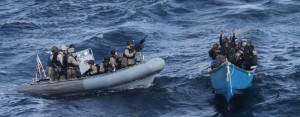What can the lessons of naval cooperation in countering piracy off Somalia teach us?
What can the success of counter-piracy operations in the Indian Ocean tell us about military cooperation more generally? Counter-piracy was the quintessential example of what cooperative sea power could accomplish, and the success of operations off Somalia helped drive the thinking of many American sea power theorists. The “Thousand Ship Navy” concept developed just as the U.S. Navy and other forces were beginning to step up counter-piracy operations off Somalia, and hoped to lay the foundation for the creation of similar operations around the world.
Sarah Percy, a scholar at the University of Queensland, has published a new article investigating the multinational counter-piracy coalition that developed off Somalia. Percy argues that the successful cooperation in counter-piracy operations resulted from emphasis upon a networked structure, rather than upon a traditional hierarchy. Instead of establishing rigorous command and control systems with specific delineations of responsibility, the counter-piracy coalition relied on contributions that a variety of navies willingly provided, with cooperation and communication facilitated by institutional “hubs” such as NATO and the European Union. The networked structure enjoyed the benefits of a relatively uncomplicated legal structure (everyone agrees that navies have the right to arrest pirates) and of institutional similarity (almost every navy is organized on basically the same lines), which also reduced the potential for friction.
The success of the ad hoc, networked military collaboration off Somalia may also have had something to do with the ends sought by the various navies involved. National governments wanted legitimacy and prestige; the navies themselves sought organizational prestige and a means of making claims to resources; the navies also sought experience in long-range, sustained operations. In short, collaboration may have worked because the navies had compatible aims, with little serious to quibble over.
This suggests that success in building a networked structure of cooperation benefited greatly from factors directly associated with the specific context of this mission. A networked collaborative structure might work less well in other contexts, including high intensity warfare (collaboration between Western Allied forces in World War II, for example) or in situations where organizational goals diverged substantially (NATO cooperation in Afghanistan, for example).
But Percy suggests that while many multilateral operations may not fit well within the networked structure, prospects are better for maritime multilateral ops. Many maritime missions short of high intensity naval war (something we haven’t seen for decades) can succeed without hierarchical command and control systems; disaster relief, counter-narcotics, and other missions might fit within a networked structure. And as Percy notes, most navies are organized in roughly the same way, and all face the fundamental problem of operating within an otherwise unpoliced “commons.” Altogether, Percy’s work suggests that cooperative, networked strategies of sea power deserve further attention.
thediplomat.com



